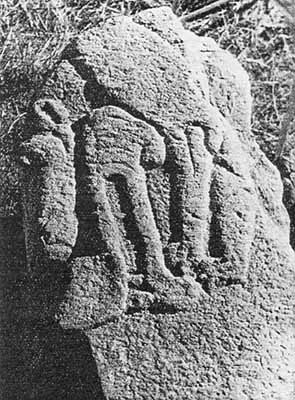
| Court art of Sogdian Samarqand in the 7th century AD | |||||||||||||
| Home | General | Western Wall | Northern Wall | Eastern Wall | Southern Wall | Bibliography | |||||||
 |
|
|||||||||||||||||||||||||||||||||||||||||||
Eastern wall
| As we have seen on the previous
page, person 7A stands near to a huge dark-coloured quadruped. We
repeat this section on the right side: Figure 7A seems to rear up either to protect or to attack the neighbour. This scene, regretably lost today, finds a very close parallel with the following piece: |
 |
 |
Left: This is the top end of an early Turkish monument,
the famous inscribed stele from Bugut (Chanuy-gol valley, Mongolia). The piece
dates to the end of the 6th century AD and bears inscriptions in Sogdian
and Sanskrit. According to S. G. Kljaštornyi and V. A. Livšic, the topmost relief is an abbreviaton of the ancient Turk genealogical myth. The carvings depicts a she-wolf and a rather crude human person. [ Image after Kljaštornyi, S. G. - Livšic, V. A.: The Sogdian inscription of Bugut revised - In: Acta Orientalia Academiae Scientiarum Hungaricae (Budapest), t. XXVI, 1972, pp. 69-102 (p. 96, fig. 3) ] |
The contents of this Turkish myth runs as follows:
| The ancestors of the Turks lived on the shore of a great marsh, or, according to another version, on the eastern shore of Lake Xi-hai ("Western Sea", i.e., the delta of the Etsin-gol with seas Gaxun-nur and Sogo-nur). Warriors of a neighbouring tribe attacked and exterminated them. Only a ten years old boy survived. This boy was brought up by a she-wolf. Later the wolf was made pregnant by the boy. Finally the wolf escaped the enemies and came to the mountains north of Turfan (Gaochang). Here the she-wolf gave birth to ten sons. These sons married ten women from Gaochang. One of the sons, called A-shih-na, became leader of the A-shih-na clan... |
We will use this interesting parallel as a kind of key to interpret the eastern wall murals. A justification for this is given with the Chinese account on Kushaniyah (eastern wall decoration = Turkish context).
Let us first remember what we have seen on the right part of the eastern wall:
| Upper register | [Entrance of the hall] | a male person close by a she-wolf | lost | lost |
| Lower register | a mother with her child | childlike figures fighting birds | water scene, with whitish people and with animals |
In my opinion we have to read the murals from the lower right (corner of the wall) to the lower left (entrance to the room). There, the succesive contents moves to the upper register where it is to read from left to right.
Now, our interpretation runs as follows:
1. The sea Xi-hai is depicted as the water scene on the lower right. Here the ancestors of the Turks used to live.
2. Enemies attack the peaceful people. They kill even the birds living on the shore of the sea. This is the scene with dwarfish figures shooting white birds. The scene obviously depends on western ideas of "fightings between pygmies and cranes". In our opinion this strange motiv was introduced to emphasize the supernatural contents of the tale. [OK, a somewhat weak argument...]
3. On the shore of the sea a single mother remained. She tries to save the boy who shall marry a she-wolf later.
4. [The tale turns upwards to the second register.] The only surviving boy marries the she-wolf. (Compare image on top of this page, figure 7A). Action should now turn to the region of Turfan...
5. The scene continues to the right, but everything of the murals is lost, except the boots of a further person (figure 7B, compare image on top of this page).
In our opinion, one decisive point is the localization of the story in eastern regions, and with the Turfan-episode (cp. above) even in Eastern Turkestan. This would meet the general layout of the walls according to the cardinal points.
Our tentative interpretation comprises only the right part of the eastern wall. The left part murals are even more enigmatic. But keeping in mind the general intentions of the wall decoration in this room, there should have been a certain connection in contents of both parts.
go to first page on the eastern wall's right part
 |
|
|||||||||||||||||||||||||||||||||||||||||||